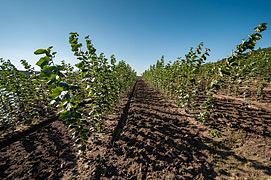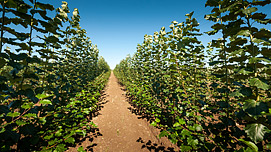Our product
The company Verbava a.s. is engaged in wood chip production, exclusively fromspecifically cultivated biomass from short rotation forests (SRF) for energy production
We currently cultivate trees for energy production in plantations with an area of more than 750 ha in the Czech and Slovak Republics, Poland and Ukraine. For these purposes, we use several species of fast-growing poplars and willows. Our growing technology is based on the idea of maintaining maximum profitability of plantations for a period of at least 20 years. Therefore, we establish plantations only on suitable sites allowing the healthy and rapid growth of cultivated tree species.
Tree species for energy production are characterized by fast growth, good calorific value and relatively small requirements for cultivation. Their advantage is the high above-ground biomass yield within a short period of time, thus usually allowing repeated harvesting from the stump every three years. They are purposely cultivated on clear cuttings. Japanese poplar, a J-105clone, is used most often in our regions. This is an extremely suitable energy tree because this species has a very rapid growth after cutting (yield up to 90 t/ha of fresh biomass during a three-year rotation period), it also has a high calorific value. It has already been planted in the Czech Republic for 20 years and, if well attended, grows reliably up to the altitude of 600 m. It is a hybrid between balsam poplar and black poplar, similar to the other cultivated clone Oxford.
We are comparing established clones in our plantations with new poplar clones bred in Italy - AF2, AF8 and Monviso. At selected locations, we also cultivate clones of willows bred in Sweden – Tora, Tordis a Inger.
 The range of SRF cultivated in plantations of the company Verbava a.s.:
The range of SRF cultivated in plantations of the company Verbava a.s.:
- Populus nigra × Populus maximowiczii („Japanese poplar“), clone J – 105
- Populus maximowiczii × Populus × berolinensis, clone Oxford
- Populus deltoides × Populus nigra, clone AF2
- Populus × generosa × Populus trichocarpa, clone AF8
- Populus × generosa × Populus nigra, clone Monviso
- Salix schwerinii × Salix viminalis, clone Tora, Tordis
- Salix triandra × viminalis, clone Inger
Wood chips are a stiff biomass. This is a clean, completely natural and 100 % renewable energy source. Wood chips are produced after logging, from waste of wood-processing plants or directly from specifically cultivated wood biomass.
Wood chips serve mainly for the generation of heat, electricity or for the simultaneous generation of heat and electricity by means of cogeneration. It is a very cheap biofuel because its production does not require additional energy, e.g. for drying and pressing. Wood chips also have a good calorific value, comparable to brown coal (about 8-15 GJ/t). The calorific value is dependent on the moisture content, the recommended moisture content is around 15-50%. Hammer crushers or chippers used to achieve finer wood chips are used in the production of wood chips.

Wood chips supplied by us:
Fraction: up to 6 cm
Moisture content: up to 50 %
Ash content: up to 3 %
Calorific value:8–10 GJ/
Biomass is the sum of all substances of biological origin, of all living and non-living organisms. It belongs to the most important renewable energy sources.
Biomass for energy purposes is cultivated either specifically using energy crops (including fast-growing woody species), or biomass waste including, in particular, plant waste from agricultural production (straw), wood residues from forestry and industrial production (e.g. paper industry), organic waste from the food industry and livestock production as well as municipal biowaste is used.
Biomass offers a series of options for energy utilization, especially direct combustion for generating heat or electricity, then cogeneration and biogas or liquid biofuels. There is progressively a wider utilization of biomass in the Czech Republic, it is already routinely incinerated, most often in the form of wood chips, together with coal in conventional power plants, and this trend will certainly intensify. It is currently planned to construct plants designated for the combustion of net biomass.
Although CO2, one of the most important greenhouse gases, is released during the combustion of wood chips as during any other combustion process, it is reabsorbed during plant growth so that the combustion of wood chips does not contribute to the greenhouse effect.
Recently, establishing plantations of fast-growing woody species is on the rise. The use of biomass has less impact on the environment than conventional energy sources. It is now undisputed that the future trend is towards the use of clean energy.
The future is full of questions. We are looking for answers.




